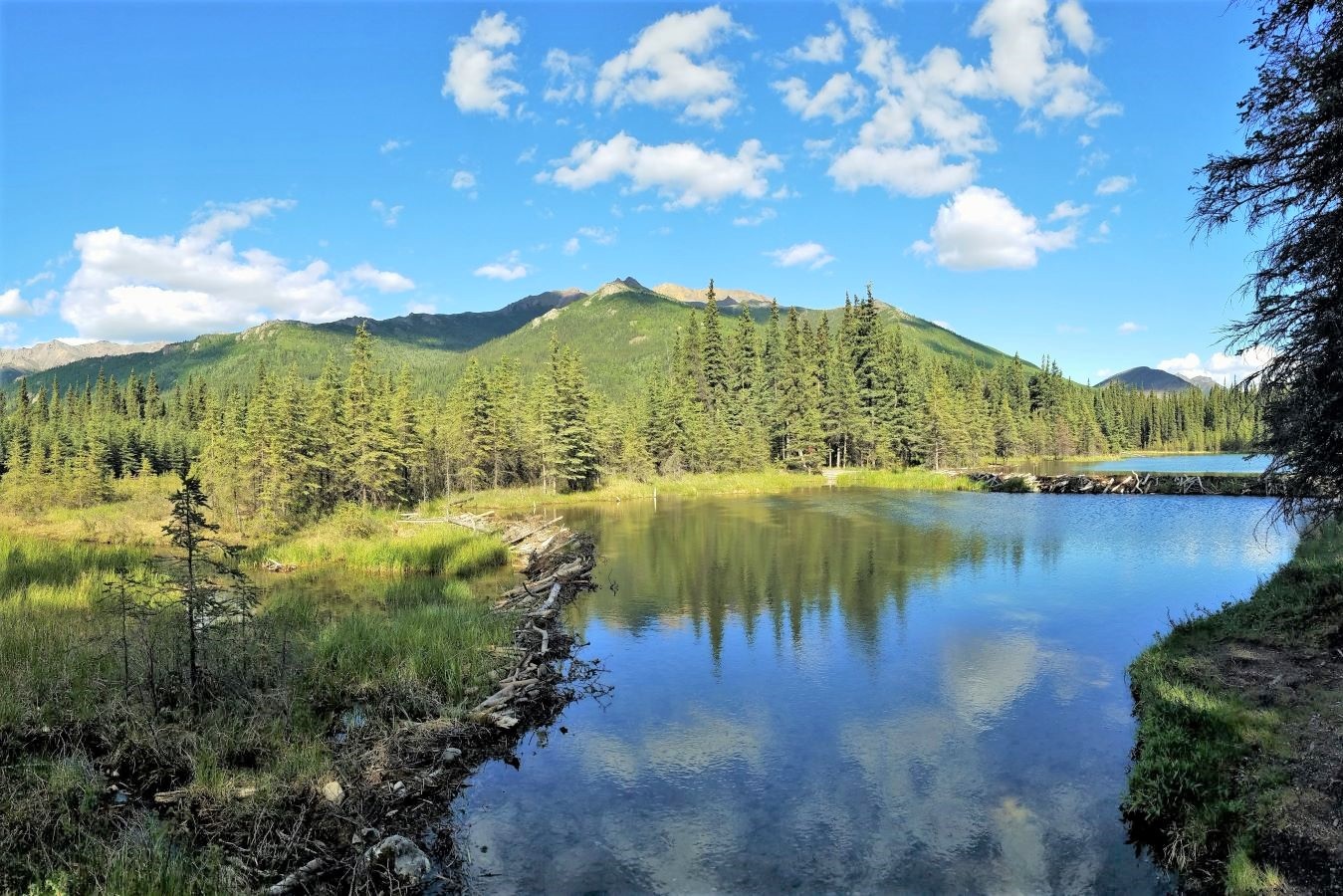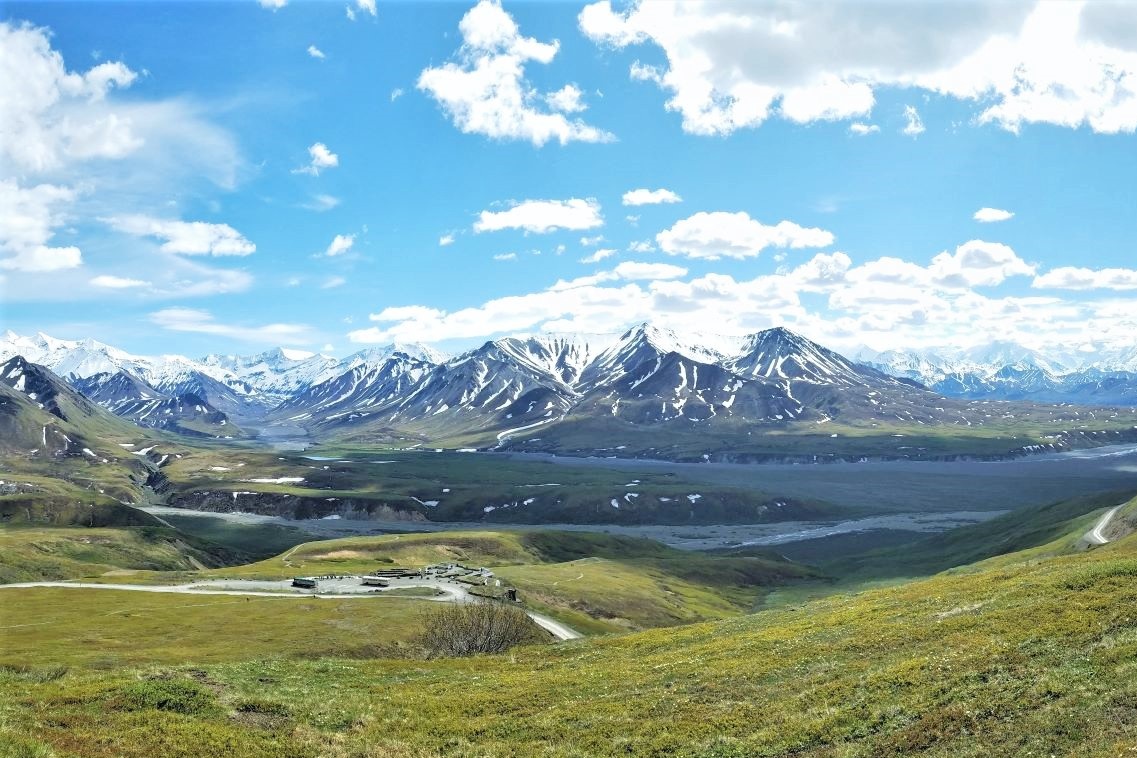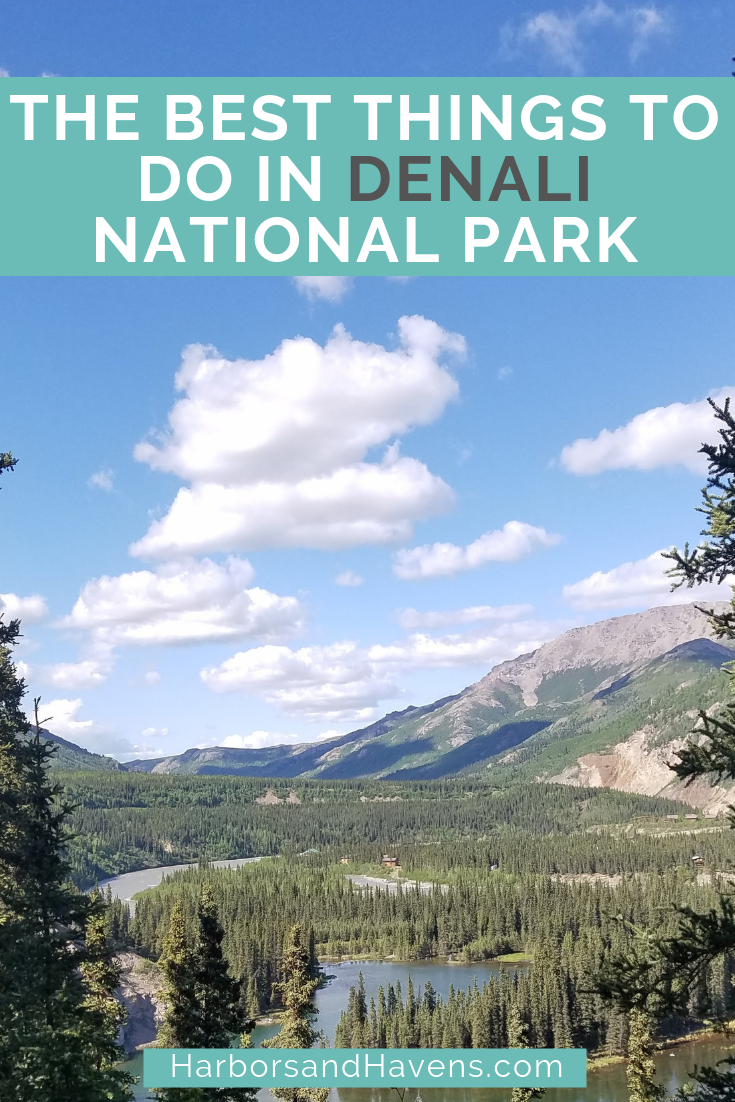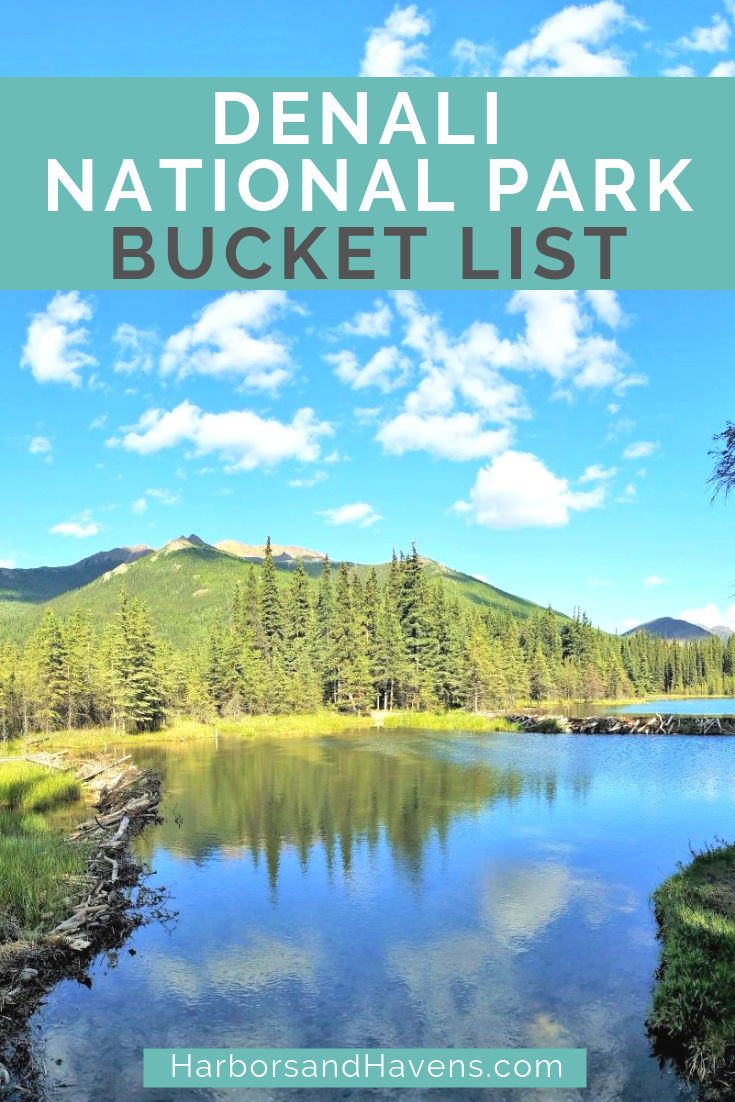15 of the Best Things to Do in Denali National Park Alaska
The best things to do in Denali National Park include unforgettable hikes, scenic bus tours, and wildlife watching.
Home to North America’s tallest mountain and more than 6 million acres of wilderness, Denali National Park and Preserve serves up a full slate of outdoorsy activities and epic vistas in Alaska. Whether you’re looking for adventurous things to do in Denali among the peaks and rivers, or prefer quiet nature walks, wildlife watching, and guided sightseeing trips, there’s plenty of summer activities here to keep visitors enthralled for days.
Use this Denali National Park guide to help plan out free things to do, find the best hikes in Denali for your travel crew, and make sure you don’t miss out on any hidden gems this bucket-list destination has to offer.
15 Epic Things to Do in Denali National Park
Scope out the Denali Visitor Center
The visitor center at the park entry offers a nice intro to what you can expect during your time here. Start by watching the 20-minute long “Heartbeats of Denali” and its accompanying educational films for a preview of the Alaskan wilderness and wildlife safety tips. Then, stroll around the exhibit area to see fossils, footprints and other critter displays.
This is also the spot to pick up permits and meet up for national park ranger walks. It’s only open May-September, since that’s when most people arrive.
Elsewhere around the campus, you’ll find a bookstore and gift shop, baggage storage area, and a restaurant that also has grab-and-go bites perfect for picnic lunches. Before you leave, make sure to grab a trail map and a postcard.
Visit the Sled Dogs
Canines have been working the winter wilderness of Denali for the past century, carrying supplies and rangers as they conduct research, assist visitors and monitor for illegal activity in the vast preserve. Alaskan huskies serve these purposes better than motorized equipment since they’re more reliable and don’t break down in the cold temps.
The furry rangers live at the park’s kennels and in summer, visitors can pet them, hear about what they do, and watch mushing demonstrations. Since most of the dogs’ work is reserved for the snowy season, local volunteers take them out on daily walks and runs to let them burn off any pent up energy. When the dogs retire at age nine, they’re adopted out to active and outdoorsy homes.
Join a Ranger Program
Throughout the summer, special programs led by park rangers include free guided hikes and interpretive presentations. Morning nature walks depart from the Denali Visitor Center and cover up to 3 miles in the nearby forests. When it’s open, the Eielson Visitor Center has noon hikes, but you have to have a ticket on a transit bus to get here.
Hike the Horseshoe Lake Trail
This 2-mile trail near the park entrance circles Horseshoe Lake and traces a stretch of the Nenana River, making for lots of scenic photo stops and chances to encounter wildlife along the way.
The first section involves a short walk up to an elevated lake vista, followed by a 250-foot drop to the shoreline, which means an equally steep climb back up at the end of your hike. Down by the lakeside, a short offshoot path leads to a beaver dam, and the primary trail branches off in two directions, forming a loop.
Aside from the final ascent at the end to reach the trailhead, it’s a fairly easy route. The most exciting section is the west side of the lake where the dusty footpath skirts narrowly between the water’s edge and a steep and rocky hillside. The views from this end of the glistening lake surrounded by soaring pines and a mountainous backdrop are particularly striking.
Climb Mount Healy
Adventurous trekkers can hit the Mount Healy Overlook Trail, also conveniently near the park entrance. The out-and-back option runs 2.7 miles each way, ascending 1,700 feet to a viewpoint on the mountainside.
Along the route, you’ll pass through forests of spruce, marching above the tree line on a series of switchbacks. The payoff is a sweeping panorama that might include Denali on a clear day.
The climb is one of the steepest and most strenuous in the park. You can make it even more challenging by continuing another 1.5 miles to summit Mount Healy, an unofficial and potentially dangerous path that should be attempted cautiously.
Drive Denali Park Road
The only passage into the national park, Denali Park Road spans 92 miles. The majority of this is unpaved and closed to private vehicles, but those traveling with a car can still explore the first 15 miles. Free park shuttles also tread this route, but self-driving means you can stop for photos and wildlife watching at the pull-out spots whenever you wish.
The route goes as far as Savage River, where there is a small parking lot and a couple of trail options by the waterside. Along the paved way, scenery includes trickling creeks, vast fields dotted with trees, and mountains in every direction.
Aching to drive further into the park? In the past, a lucky few picked by lottery system got the chance to drive the entirety of Denali Park Road at the end of the summer. You can look up how to apply here. Since Denali Park Road is currently closed at mile 43 due to a landslide, guests can drive up to mile 30 when the fall season starts (around mid September) until the road closes from snowfall.
In summer, you’ll need to book a ticket for a Denali National Park tour or transit bus to see the rest of the preserve (keep reading for that info).
Walk the Savage River Loop
This easy loop trail traces the Savage River, with a water crossing via bridge to return to the start on the opposite bank. A total length of 1.7 miles makes it manageable for just about every level of hiker, and you can get to the trailhead by either car or free park shuttle.
The river cuts between two mountain ridges here, so you’ll feel as though you’re walking in a canyon with towering hills above on both sides as you stick close to the banks.
To add a little adventure, consider hopping on the Savage Alpine trail from here instead. The strenuous option is 4-miles one way, climbing into the mountains and connecting to the Mountain Vista rest stop, where you can catch a shuttle back to the start.
Camp in Denali
Is there any better way to experience the great outdoors of Denali than sleeping under the stars? (Tucked safely into a tent, of course). The park has six campgrounds stretching from the entrance to 85 miles into the wild.
The rules and amenities of each are quite different, including whether RVs are allowed, potable water is available, or campfires are prohibited, so check the details of each site carefully before arriving. Reservations should be made online ahead of time (as early as Dec. 1 for the next summer season) and a max of 14 nights in the park is permitted.
A couple of interesting things to note — while the rest of the campgrounds only open from May or June to September, you can camp at Riley Creek near the entrance year-round, and it’s free outside the summer season. And, the Teklanika River campground at mile 29 allows cars/RVs to access the site as long as they book for three nights, despite the road being closed to other private vehicles past mile 15. Wonder Lake campground is the farthest within the park, at mile 85, and the closest to Denali, less than 26 miles away.
All of the Denali National Park camping sites can be reached via shuttle (the ones past mile 15 require a ticket), and special camper buses come with space for equipment.
Bike Denali Park Road
Denali Park Road is currently closed at Mile 42 due to a landslide.
Cycling down Denali Park Road is a really cool way to experience the park and get up close to nature. Bikes are permitted on the entire 92 miles, barring any road closures, though you’ll need a transit ticket if you want to use buses to move you through parts of the park.
If you want to trek through on a multi-day cycling trip, you can do so by camping along the way, though you’ll likely want to stop or pick up a ride after mile 35, where there’s a gap in overnight camping sites until mile 85. Here’s more info about biking in Denali.
Fly Over the Park
Book a Denali Bus Tour
Denali Park Road is currently closed at Mile 42 due to the Pretty Rocks landslide. Some bus tours are still available.
While there’s plenty of thrilling hikes and meandering moose along the easily accessible first 15 miles of Denali Park Road, a trip further down the 92-mile route is a must to really experience this breathtaking wilderness full of mountains, valleys and rivers.
The best and most convenient way to soak up the the varying landscapes and watch for wildlife is on Denali bus tours. Two styles are available — guided tours and transit buses. Guided bus tours are the priciest, but they include a naturalist bus driver to narrate the trip and provide information along the way, as well as snacks and drinks on most itineraries. Passengers stay with their crew the whole day and you can select from a few different destinations.
In past years, the transit buses were available to four different turn-around points for different prices— the Toklat River at mile 53, Eielson Visitor Center at mile 66, Wonder Lake at mile 85, and Kantishna at the end of the road, mile 92. Currently, you can only ride out to the East Fork River due to a road closure from a landslide. The bare-bones tours allow riders to hop off at any point and hop back on another green bus when space allows, giving more flexibility to those who wish to hike or sightsee on their own. You’ll need to bring along lunch, though, as food and beverages aren’t available to purchase past the bus depot.
Both excursions make scheduled rest stops and pause for wildlife sightings. Tickets can be reserved online ahead of time if you want to make sure to get a spot at the best times available. It’s a long and slow journey (up to 12 hours round trip depending on how far you go), so consider how much time you’ll want to spend off the bus when selecting your departure. These tours typically begin in May for the summer season.
Check Out the Eielson Visitor Center
The Eielson Visitor Center is closed in 2022 due to the Pretty Rocks landslide at Mile 42 on Denali Park Road.
Located at mile 66 of Park Road, this rest stop and interpretive center is notable for its sustainable features and low profile. The building is tucked into a slope, partially buried under the hills, and disrupted landscaping from the site was moved to the roof terrace to help disguise it, making the whole thing barely visible from the road.
It’s also LEED-certified platinum, which is the top level from the Leadership in Energy and Environmental Design. Some of its renewable-energy features include solar panels, a hydroelectric system, and solar-heated water in the restrooms.
Inside, visitors will find a wilderness-themed art gallery, park info and a picture-window staring straight at Denali. When the mountain is out on clear days, you can see it and the surrounding range easily from this stop.
Transit buses that terminate here typically only linger for about 45 minutes, so if you want to stay longer to hike one of the surrounding trails, you’ll need to hop on a different bus to return to the entry. Keep in mind that you may have to wait if the buses are full, though late in the day there tend to be more empty seats.
Hike the Thorofare Ridge Trail
Thorofare Ridge is not currently accessible by bus due to the landslide on Denali Park Road.
One of just a handful of official trails past the entrance zone of the park, this one is near the Eielson Visitor Center, reached via transit buses that go to Eielson, Wonder Lake or Kantishna.
The hike starts across the road from the visitor center and climbs about a mile up the Thorofare Ridge, for an elevation gain of 1,000 feet. The views get more impressive as you make your way along the steep incline, with a panorama from the top that includes dozens of peaks and Denali when it’s out.
Photograph Denali from Wonder Lake
Wonder Lake is not currently accessible by bus due to the Pretty Rocks landslide on Denali Park Road.
Arguably one of the best viewpoints of Denali is accessed from Wonder Lake, where the aptly named Reflection Pond mirrors the image of the mountain on clear days. Many a postcard photo has been snapped at this locale, and you can try your hand at photographing it, too, if you’re lucky enough to visit when the mountain is peaking out.
To get here, you’ll need to purchase a bus ticket to Wonder Lake or Kantishna. The latter option passes close to the pond, but the first veers off toward a campground a couple of miles away. If you hop off on Park Road before the turn, it’ll be a much shorter walk of about a third of a mile.
If you want to wait and see if Denali is visible on the day of your bus excursion before purchasing a ticket all the way to Wonder Lake (they increase in price the further you go), you can buy a ride to Eielson and add an extension ticket from there in cash.
Trek in the Wilderness
Larger than a handful of states, Denali National Park and Preserve has seemingly endless wilderness to explore in its more than 6 million acres. While a dozen or so marked trails exist near the park entrance, once you pass mile 15, options dwindle to few and far between.
That doesn’t mean you can’t get out and explore, though, as off-trail hiking is allowed, which opens up a world of possibilities. Since transit buses will let you hop off wherever you wish, you can start hikes along most of the 92-mile-long Denali Park Road. Riding to the farther half takes up a good chunk of the day, though, and doesn’t leave much time for trekking unless you’re camping overnight. Be sure to read all the safety tips on the park’s hiking page, and consider checking in with a ranger when you arrive to learn about wildlife closures and any other up-to-date info.
If you want to experience Denali National Park hiking in the wilderness, but prefer to have a pro alongside, check into the discovery hikes offered with park rangers. These outings are an adventurous experience potentially involving water crossings, uneven and muddy terrain, and strenuous elevation changes. You can only sign up a day or two ahead of time once you arrive.















